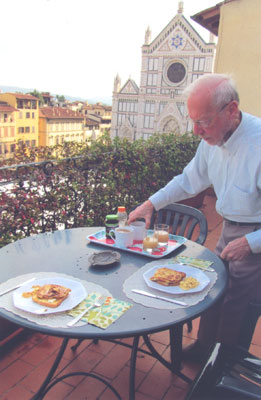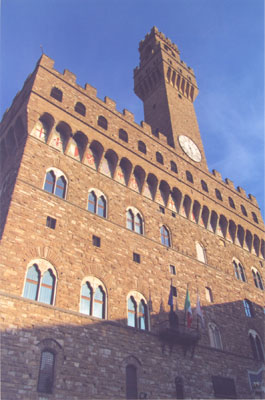Beneath Florence’s Palazzo Vecchio
This item appears on page 62 of the April 2013 issue.
(Part 1 of 2 on Italy)
Florence is one of Italy’s most exciting cities. Of this there is little doubt. There are good hotels and even better restaurants and cafés. The museums are among Italy’s best, and the shopping’s superb. There’s so much to see and do that visitors are in danger of “tourist-itis,” a condition in which sights start to blur and merge into each other.
There are three iconic sights that even the busiest visitor should not miss: the Baptistery and the Duomo (Cathedral); Santa Croce Church, and Palazzo Vecchio in the Piazza della Signoria.
Thousands flock there — and well they should — but few know that beneath these three famous Florentine sights lie much older ones dating back to the earliest days of the city as a roman colony.
Founding of the city
It was Julius Caesar who founded Florentia in 59 BC on a strategic route 175 miles north of Rome where the Via Cassia crosses the Arno River. This colony eventually became the administrative center of the region.
As a colony, Florentia boasted all the amenities of a city associated with Rome. The Baptistery with bronze doors by Renaissance artists Andrea Pisano and Lorenzo Ghiberti and the Cathedral with Filippo Brunelleschi’s dome lie atop a Roman-era palace, itself steps away from the Roman Forum, where the Piazza della Repubblica now stands.
Santa Croce, where Michelangelo, Galileo and Machiavelli are buried in elaborate Renaissance tombs, lies above the Roman amphitheater. And the fortress-like Palazzo Vecchio, Florence’s town hall for the past 700 years, dominating Florence’s most famous square, Piazza della Signoria, lies on top of Florentia’s Roman Theater.
It is the remnants of this theater that my husband, Paul, and I were fortunate to visit on our most recent trip to Florence in October 2012.
Beneath Piazza della Signoria
Florentia’s theater was constructed about 59 BC at about the same time as the colony’s founding, which indicates the importance of a theater in the life of a Roman colony.
It was semicircular in shape and quite large — 328 feet long and 115 feet wide. It is estimated that the theater could seat between 8,000 and 12,000 spectators, or about half of the colony’s population.
It not only extended beneath the present-day Palazzo Vecchio but under much of today’s Piazza della Signoria and beyond. Remnants of the theater have been found beneath the 15th-century Palazzo Gondi, which lies across the narrow street from the Palazzo Vecchio.
The entrance to the excavation site is on Via de’Gondi, just past the southeast corner of the Piazza della Signoria. Only a small portion of the theater has been excavated. To make it easier to visualize, at the entrance to the ruins there is a large mock-up of the present-day city showing where Roman ruins are known to exist beneath.
Catwalk stroll
Visitors are guided along catwalks to a section of the cavea, the theater’s tiered seating area, about 13 feet below the present-day street. You can see steps, arches and walls enclosing the orchestra, the space directly in front of the stage reserved for dignitaries.
Most interesting is the vomitarium, one of many passages into the theater, as well as piles of large broken wine jars gathered together in one area. Our guide explained that these were probably deliberately destroyed to create drainage for water, not the result of an all-out party bash as suggested by one visitor.
This theater was probably used for about 500 years until sometime in the fifth century AD. After that, it was used as a quarry for its ready-cut stones, maybe even for the building of the Palazzo Vecchio, which was completed in 1302.
Along with all the Roman-era ruins, visitors can see the foundations of later structures, including medieval buildings and wells. It’s these layers of history that make a visit so interesting.
The Roman theater was first discovered in 1875, when roadwork was in progress on Via de’ Gondi, and excavations have continued intermittently, from 1930 to 1935 (during Mussolini’s era), in the late 1990s and, most recently, between 2004 and 2010. The site has been open to the public since September 2010.
How to visit
To visit the Roman theater excavation site, reservations are necessary. You can call in advance (055 276 8224 or 055 276 8558 in Florence), but it’s best to go directly to the Palazzo Vecchio’s ticket desk and sign up for a tour in person.
Tours are usually given on Saturdays and Sundays to small groups and last about 45 minutes. Most tours are in Italian, although sometimes English is offered. It’s worth the visit, even with an Italian tour and even if you do not understand Italian, for the chance to see something unique.
The tour, itself, is free, but you must buy an admission ticket to the Palazzo Vecchio, which permits you to wander through the palazzo’s grandiose public rooms afterward. A ticket costs €8 (near $11).
Palazzo apartment
For our 17-day stay in Florence, we rented an apartment in the Palazzo Antellesi [website currently under construction] (Piazza Santa Croce 21, 50122 Firenze, Italy; phone, in US and Canada, 845/704-2426 or email palazzoantellesi@florencerentals.ne). The palazzo was built in the 16th century on the south side of Piazza Santa Croce for a wealthy merchant family.
In the 17th century, the façade was entirely frescoed, although little of these 400-year-old paintings remains. More recent frescoes were restored in 1925.
It was perfect for us to live in a Renaissance-era building while visiting this quintessential Renaissance city. Its location on one of Florence’s most famous squares next to one of its most famous churches was an extra inducement.
The Palazzo Antellesi has been divided into upscale apartments, no two alike in either size or decor. We selected the “Mimi” apartment, a 2-bedroom, 2-bathroom apartment with a full kitchen, living room and dining room. There was a working, wood-burning fireplace as well as a washer/dryer and a dishwasher.
One huge plus of our fifth-floor penthouse apartment, with elevator, was the large terrace overlooking the piazza and Santa Croce Church. The back windows had lovely views of adjacent red-tile roofs and the church of San Miniato and the Tuscan hills off in the distance.
We paid $5,797 for our 17 nights ($341 per night). This did not include utilities, which cost us an additional $104 (depends on usage). Pricey, but how often do you have the opportunity to live in a Renaissance palace?!


